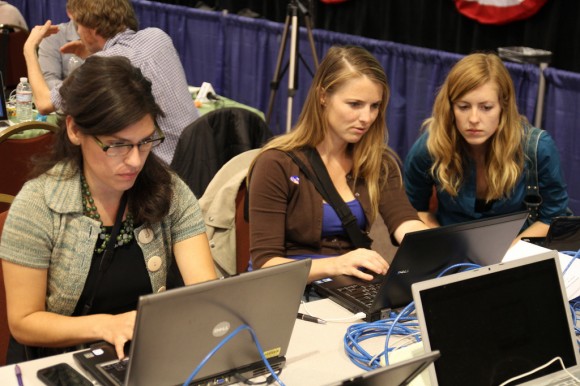A collection of @KDMCinfo tweets during Will Sullivan’s multimedia workshop on mobile reporting tools and tips.
Category Archives: Multimedia
Learning to Teach Multimedia Journalism
This post was originally published on PBS MediaShift, Jan. 7, 2011.

On the right, multimedia journalism students, Christina Maggiora and Andie Adams, work alongside KPBS reporter Ana Tintocalis during election night in San Diego.
Doing multimedia journalism and teaching it are two very different things. The past semester marked my first as an adjunct professor. It was probably the best thing I could have done for my own education.
At KPBS, I’ve produced online news content using audio, video, photography, slideshows, visualizations, social and interactive media. So when I was offered the opportunity to teach a multimedia journalism course at a local university, I jumped right in. After all, I had already led a number of training workshops. This is going to be easy, right? Yeah, right.
Continue reading
Journalist’s Toolbox Updated for #spj10
This post was originally published on the Journalist’s Toolbox, a resource offered by the Society of Professional Journalists. It was republished here with permission.
SPJ National Convention
Some great links from Jeff Cutler’s online tools session and others on Monday: Buzz.Yahoo.com for mining story ideas; Search.Twitter.com Advanced for detailed Twitter and hashtag searches and WalletPop, a finance site that helps you find the most dangerous neighborhoods for crime. More to come later in the convention!
Add SPJ National Convention
The Journalist’s Toolbox will post tweets live Oct. 3-5 from the convention in Las Vegas. Just follow @journtoolbox and the #spj10 hashtag.
Copy Editing Resources
It’s not the fanciest site on the Web, but DrGrammar.org has a great quick-reference page. Another helpful tool: Thsrs, the shorter thesaurus, which produces shorter synonyms for any word you type in. It’s a very helpful tool for writing short, tight headlines.
Twitter Resources
We’ve added dozens of new resources, including Twitter guides for journalists, backgrounds, URL shorteners and other tools on the Toolbox’s Twitter Resources page.
Mobile Journalism Resources
The Toolbox has launched a Mobile Journalism page that features links to app-making tools, readings on mobile media strategy and a list of recommended apps for journalists to use on their smart phones.
The Future of Multimedia Is Mobile
[display_podcast]
According to a recent Nielson study, it is estimated that one in two people will own a smartphone by the end of 2011. This rise in smartphones shows more than a consumer preference. Gartner Inc., a technology research company, predicted earlier this year that smartphones will become the most popular devices people use to access the web by 2013. This study reflects a growing trend in phone preference but also foreshadows the future of multimedia journalism.
Continue reading
Discovering the Basics of Multimedia Journalism
[display_podcast]
Audio, video, photo, slide show, text, linking, tagging: with so much media at their disposal, news outlets are continually redefining what it means to produce a “multimedia†story.
This can be a liberating process, with a variety of media to show one’s creativity. On the other hand, continuity is hard to maintain with so many elements. Web reporters must achieve a balance between creativity and continuity.
Continue reading
Traditional Craft Is Important Foundation for Multimedia Journalism
[display_podcast]
The way we consume our news continues to shift from print to online publications. As a result of this decline in newspaper circulation, more than 10,000 journalism jobs were lost last year. This radical change leaves many questioning what the future holds for journalists. Many professionals in the field believe that fundamentals of traditional journalism are just as important as ever to build the foundation for effective multimedia journalism.
Continue reading
Multimedia Skills Assessment Survey
In developing the syllabus for the Multimedia Journalism course at PLNU (WRI 430), I tried to keep students’ future employment in mind. What skills are journalists missing when they enter the marketplace? What are employers looking for? What projects can I assign that will help them get hired?
I decided to focus our time on these areas:
- Optimized news writing for online audience
- Storytelling across all types of media
- Maximizing the strengths of each medium
- Innovation in story approach
- Strong online presence
- Fluency in social media
- Live field reporting for Web
On the first day of class, I surveyed students on their abilities with multimedia. I asked about areas we probably won’t cover (I want to do HTML5 instead of Flash as much as possible), but the results were enlightening. I’ve already adjusted the course schedule; they’re more advanced than I anticipated.
The survey’s emphasis on technology shouldn’t imply we’ll only work on building tech skills. I plan to focus our time in class on big picture concepts, optimizing story through the technology. But in order to tell stories powerfully online, the technical elements need to become second nature.
Continue reading
